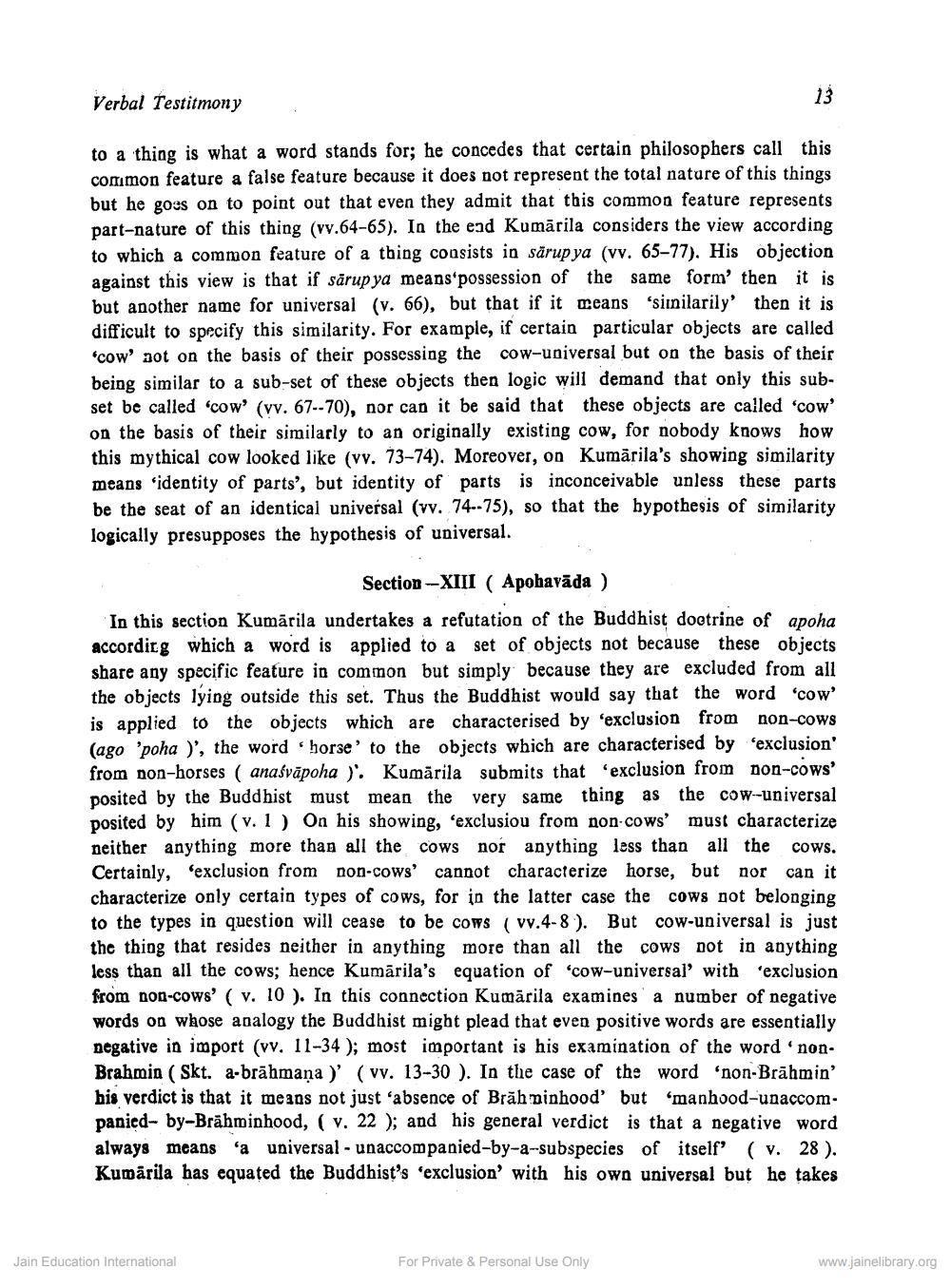________________
Verbal Testitmony
to a thing is what a word stands for; he concedes that certain philosophers call this common feature a false feature because it does not represent the total nature of this things but he goes on to point out that even they admit that this common feature represents part-nature of this thing (vv.64-65). In the ead Kumārila considers the view according to which a common feature of a thing consists in särupya (vv. 65-77). His objection against this view is that if särup ya means possession of the same form' then it is but another name for universal (v. 66), but that if it means 'sinilarily' then it is difficult to specify this similarity. For example, if certain particular objects are called 'cow' aot on the basis of their possessing the cow-universal but on the basis of their being similar to a sub-set of these objects then logic will demand that only this subset be called 'cow' (vv. 67--70), nor can it be said that these objects are called 'cow' on the basis of their similarly to an originally existing cow, for nobody knows how this mythical cow looked like (vv. 73-74). Moreover, on Kumārila's showing similarity means 'identity of parts’, but identity of parts is inconceivable unless these parts be the seat of an identical universal (vv. 74-75), so that the hypothesis of similarity logically presupposes the hypothesis of universal.
Section-XIII ( Apohavāda ) In this section Kumārila undertakes a refutation of the Buddhist doetrine of apoha accordirg which a word is applied to a set of objects not because these objects share any specific feature in common but simply because they are excluded from all the objects lying outside this set. Thus the Buddhist would say that the word 'cow' is applied to the objects which are characterised by 'exclusion from non-cows (ago 'poha )', the word horse' to the objects which are characterised by 'exclusion' from non-horses ( anasväpoha ). Kumārila submits that 'exclusion from non-cows' posited by the Buddhist must mean the very same thing as the cow-universal posited by him (v. 1 ) On his showing, 'exclusiou from non-cows' must characterize neither anything more than all the cows nor anything less than all the cows. Certainly, 'exclusion from non-cows' cannot characterize horse, but nor can it characterize only certain types of cows, for in the latter case the cows not belonging to the types in question will cease to be cows ( vv.4-8). But cow-universal is just the thing that resides neither in anything more than all the cows not in anything less than all the cows; hence Kumārila's equation of cow-universal' with 'exclusion from non-cows' ( v. 10). In this connection Kumārila examines a number of negative words on whose analogy the Buddhist might plead that even positive words are essentially negative in import (vv. 11-34 ); most important is his examination of the word 'nonBrahmin ( Skt. a-brāhmaṇa )' (vv. 13-30 ). In the case of the word 'non-Brāhmin' his verdict is that it means not just 'absence of Brāhminhood' but 'manhood-unaccompanied- by-Brähminhood, ( v. 22 ); and his general verdict is that a negative word always means a universal - unaccompanied-by-a-subspecies of itself' ( v. 28 ). Kumärila has equated the Buddhist's 'exclusion' with his own universal but he takes
Jain Education International
For Private & Personal Use Only
www.jainelibrary.org




